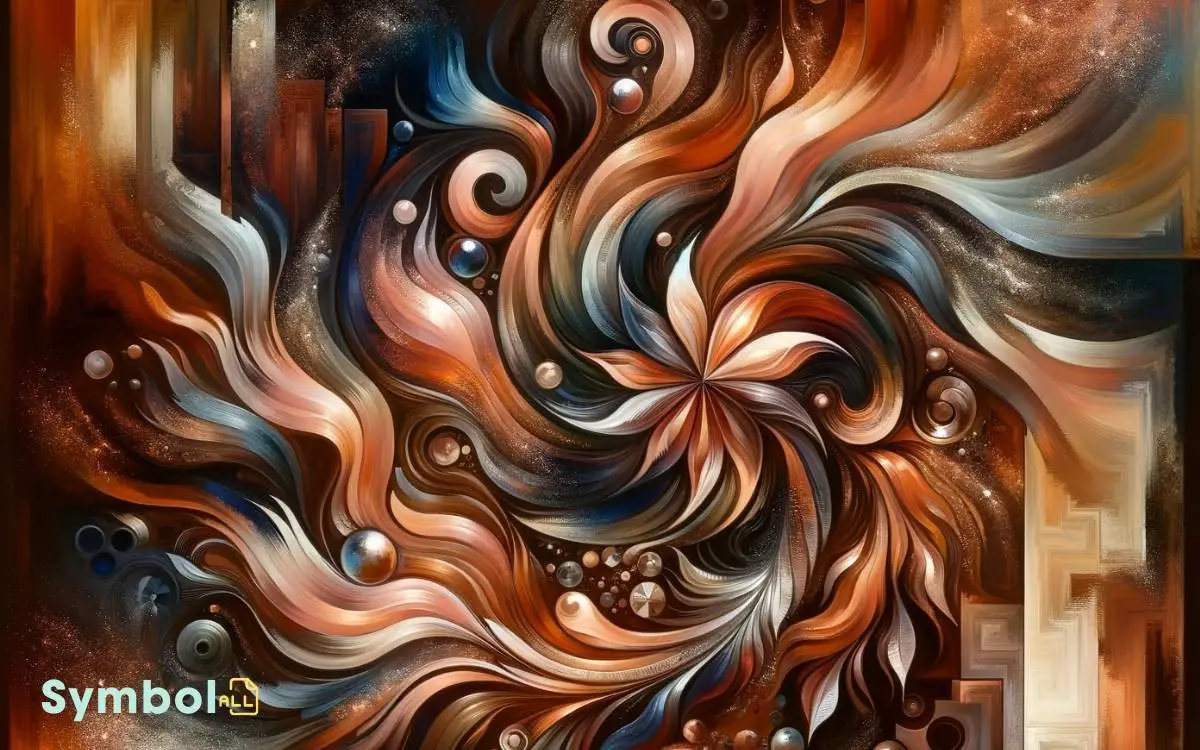What Does the Color Copper Symbolize? Prosperity!
The color copper symbolizes a profound blend of strength, prosperity, and the elemental bond between you and nature. It marks the dawn of technological advancement and economic development, reflecting humanity’s journey from the Bronze Age to modern innovations.
Copper’s rich, earthy hue connects you to the natural world, embodying growth, fertility, and resilience. It signifies wealth, not just materially but in knowledge and spirituality, enriching your understanding of cultural and historical depth.
This lustrous metal enhances your spiritual and physical well-being, promoting health, vitality, and an alignment with the Earth’s energy. Uncover how copper’s enduring legacy continues to influence your world.

Key Takeaways
Historical Significance
Throughout history, copper has played a pivotal role in shaping human civilization, serving not just as a mere material for coinage and tools, but also as a symbol of wealth, innovation, and progress. You’ll find that its significance transcends mere functionality.
In ancient societies, possessing copper signified economic strength and technological superiority, as it was essential for creating powerful weapons and beautiful artifacts.
This metal’s inherent value fostered trade networks, facilitating cultural exchanges and economic development across continents.
Additionally, its role in the creation of bronze marked the beginning of a new era, the Bronze Age, propelling societies into unprecedented levels of advancement.
Hence, copper’s historical importance is deeply woven into the fabric of human progress, illustrating how essential materials can drive civilizations towards greater achievements.
Connection to Nature
You find copper’s essence deeply intertwined with nature through its earthy tones and the harmony it shares with natural elements.
This metal not only reflects the hues of the natural world but also symbolizes the interconnectedness between the Earth’s core and the life it sustains.
Analyzing copper’s connection to nature reveals insights into how humans perceive and integrate natural symbolism into cultural artifacts.
Earthy Tones Resonance
Copper’s earthy tones deeply resonate with our innate connection to nature, reflecting the profound bond between the material world and human perception.
This resonance isn’t mere hence; it’s rooted in our evolutionary history, where the natural environment was the first canvas of human experience.
Copper’s hues, from deep browns to radiant oranges, echo the spectrum of the earth itself, from soil to sunset.
This mirroring effect isn’t just visual; it’s visceral, evoking a sense of belonging and stability. You’re not just observing these tones; you’re recalling a primal memory of the natural world.
This connection is essential, reminding us that despite technological advances, our affinity for the natural world persists. Copper, consequently, serves as a bridge, linking the tactile reality of our ancestors with our contemporary aesthetic appreciation.
Natural Elements Harmony
Delving deeper into copper’s essence reveals its harmonious relationship with natural elements, underscoring a profound connection to nature that we often overlook.
This metal, embodying the warmth and richness of the earth, resonates with the foundational energies of our world.
It’s not just a color or a material; it’s a symbol of the earth’s generosity and fertility. You’ll find that copper’s presence in natural landscapes from the verdant patina of aged roofs to the gleaming veins in stones echoes a deeper synergy with the environment.
This connection invites you to appreciate the subtle yet significant ways in which copper bridges the gap between the human-made and the natural, urging a reconsideration of how we engage with our surroundings.
Symbol of Wealth
You must appreciate that copper’s luster isn’t merely physical; it’s deeply entrenched in historical riches association, reflecting its age-old status as a symbol of wealth.
This metal’s intrinsic value has evolved, yet it retains a significant role in the modern economy, underscoring its enduring economic value.
Analyzing this metamorphosis offers insights into how perceptions of wealth and value aren’t static but evolve with societies and economies.
Historical Riches Association
Throughout history, copper has served as a potent symbol of wealth, deeply embedded in the economic and cultural narratives of various civilizations. Its lustrous sheen and rarity positioned it as a material of significant value.
You’ll find that in ancient societies, copper wasn’t just a metal; it was a marker of prosperity and power. Its use in coins, jewelry, and sacred objects across continents showcases its universal appeal and enduring significance as a wealth symbol.
| Civilization | Use of Copper |
|---|---|
| Ancient Egypt | Jewelry, Coins |
| Mesopotamia | Trade, Currency |
| Ancient China | Ornaments, Tools |
| Roman Empire | Currency, Statues |
| Indigenous Americas | Weapons, Decorations |
This table reflects copper’s multifaceted role in historical wealth, transcending mere economic value to embody cultural and spiritual significance.
Modern Economic Value
While ancient societies revered copper for its symbolic wealth, today’s economies continue to value this versatile metal for its critical role in modern technology and sustainable development.
You’ll find copper at the heart of renewable energy systems, including solar panels and wind turbines, embodying its modern economic value.
It’s not just about electrical conductivity; copper’s thermal efficiency makes it indispensable in green technology and the automotive industry, particularly in electric vehicles.
This shift towards sustainability has amplified copper’s worth beyond mere commodity to a symbol of progress and innovation.
The burgeoning demand amidst finite supply underscores its status as a harbinger of wealth in the 21st century, reflecting not only market value but also its pivotal role in shaping a sustainable future.
Industrial Impact
Copper’s integration into various industries has markedly transformed production processes, enhancing efficiency and innovation. Its conductive properties have made it indispensable in the electrical industry, revolutionizing how energy is transmitted and utilized.
In addition, its malleability and ductility have facilitated advancements in manufacturing, from electronics to construction materials.
| Industry | Impact of Copper | Example of Innovation |
|---|---|---|
| Electrical | Enhanced conductivity | High-efficiency power cables |
| Manufacturing | Improved material properties | Lightweight, durable alloys |
| Construction | Increased structural integrity | Weather-resistant roofing |
These developments underscore copper’s pivotal role in industrial progress. Its presence not only improves product quality but also propels industries toward more sustainable practices by enabling the use of energy-efficient materials and technologies.
Cultural Meanings
Beyond its industrial impact, copper also holds profound cultural meanings across various societies, reflecting its significance beyond mere material utility.
You’ll find that copper’s symbolism is rich and varied, embodying concepts that are both ancient and deeply relevant today.
- Wealth and Prosperity: In many cultures, copper has been a symbol of wealth, used in coins and trade. It’s believed to attract positive energies, leading to prosperity.
- Healing and Health: Its antimicrobial properties make copper symbolize healing, purity, and protection against illness.
- Fertility and Luck: Copper is often associated with the goddess Venus in mythology, symbolizing fertility and beauty.
- Spiritual Conductivity: It’s thought to enhance spiritual connections, acting as a conduit for spiritual energies.
These meanings show copper’s layered significance, transcending its physical properties to embody deeper cultural and spiritual values.
Artistic Representations
You’ll find that artists have long favored copper for its unique properties, employing it in sculptures and utilizing its vibrant color in paintings.
This material’s malleability and hue resonate with symbolic meanings that transcend time and culture, inviting a deeper exploration of its artistic significance.
Through sculptures and paintings, copper serves not only as a medium but also as a narrative device, enriching the visual and conceptual landscape of art.
Copper in Sculptures
Throughout history, artists have frequently chosen copper for its malleability and vibrant patina, enriching sculptures with a unique aesthetic and symbolic depth.
When you investigate the choice of copper for sculptures, several layers of meaning emerge:
- Durability: Copper’s ability to withstand time symbolizes permanence and resilience, reflecting the enduring nature of the subject matter.
- Transformation: The patination process, where copper changes color over time, mirrors life’s constant evolution, suggesting adaptability and growth.
- Connectivity: Historically, copper’s conductive properties have been associated with divine communication, implying that sculptures serve as a bridge between the earthly and the spiritual.
- Value: Its historical significance as a precious metal conveys esteem and honor, elevating the sculpture’s subject.
These aspects together weave a complex narrative, offering you a richer understanding of copper’s symbolic resonance in artistic representations.
Coppers Color in Paintings
Copper’s distinctive hue, when used in paintings, offers artists a palette that resonates with both historical significance and emotional depth, inviting viewers into a nuanced exploration of its symbolic implications.
This vibrant, warm tone bridges the natural and the divine, evoking earth’s inherent beauty and the transcendent.
In your journey through art history, you’ll find that copper’s color harbors a dual symbolism of wealth and decay, capturing the ephemeral nature of life and the unyielding passage of time. Its warm, reddish-brown hue has been celebrated in sculptures, paintings, and architectural details, often evoking a sense of opulence. Yet, as it oxidizes into verdigris, it reminds us of the inevitability of change and the beauty found in impermanence. In contrast, the symbolism of the color silver often represents purity and clarity, creating a poignant dialogue when paired with copper’s more earthly connotations.
Artists harness its rich, reddish-brown tones to craft scenes that are at once grounded in reality and steeped in metaphorical meaning.
Copper’s inclusion in a painting’s palette becomes a deliberate choice, enriching the visual narrative with layers of interpretation that engage, challenge, and enlighten you.
Healing Properties
Historically, copper has been revered for its therapeutic virtues, offering a beacon of hope for those seeking alternative healing modalities.
This metal’s healing properties aren’t only ancient wisdom but are also supported by modern science, providing you with a unique blend of tradition and innovation.
Here’s how copper can benefit your well-being:
- Antimicrobial Action: Copper possesses inherent antimicrobial properties, making it effective in reducing the presence of harmful microbes.
- Improved Circulation: Wearing copper can stimulate a more efficient blood circulation, enhancing your overall vitality.
- Joint Relief: Its anti-inflammatory properties are believed to alleviate arthritis and joint pain.
- Antioxidant Defense: Copper acts as a potent antioxidant, fighting off free radicals and aiding in your body’s natural regeneration processes.
Understanding these aspects underscores the significance of incorporating copper into your health regimen, appreciating its deep-rooted history in healing.
Spiritual Associations
You’ll find that copper’s spiritual associations are deeply rooted in its capacity to function as a healing energy channel, emphasizing its inherent ability to foster a profound connection with Earth.
This connection underscores copper’s role in enhancing prosperity and abundance, resonating through various spiritual practices across cultures.
Through this lens, copper isn’t merely a metal but a symbolic conduit for grounding, wealth, and spiritual growth.
Healing Energy Channel
Throughout the ages, many cultures have revered copper as a conduit for healing energy, attributing to it properties that align and balance the spiritual body.
This belief in copper’s healing energy isn’t arbitrary; it’s deeply rooted in its unique characteristics:
- Conductivity: Copper’s exceptional ability to conduct spiritual and physical energies enhances personal energy flow, promoting balance and well-being.
- Antimicrobial properties: On a more tangible level, copper’s natural antimicrobial qualities symbolize its ability to cleanse and purify.
- Flexibility: Its malleability signifies adaptability and resilience in healing processes.
- Durability: Copper’s enduring nature represents the longevity of health and the persistent journey towards spiritual alignment.
Analyzing copper’s symbolism in this perspective offers insights into its revered status as a healing metal, reflecting not just physical but profound spiritual associations.
Connection to Earth
Copper’s deep-rooted connection to the Earth embodies its spiritual associations, serving as a potent symbol of our intrinsic link to nature’s cycles and energies.
This metal, with its earthly hue, mirrors the planet’s core strength and resilience, reminding us of our dependence on and responsibility to the natural world.
Its presence in ancient rituals across various cultures highlights a universal recognition of its grounding properties.
These practices, deeply embedded in spiritual traditions, utilize copper’s conductive nature to enhance our connection to terrestrial forces, facilitating a harmonious balance within ourselves and with the environment.
Analyzing copper’s symbolic significance, you’ll find it’s not merely a physical element but a bridge to understanding the interconnectedness of life, encouraging a respectful and symbiotic relationship with the Earth.
Prosperity and Abundance
In the domain of spiritual symbolism, copper is often associated with drawing prosperity and abundance into one’s life, embodying a magnetic quality that attracts wealth and success.
This connection isn’t merely superficial; it’s deeply rooted in various spiritual and cultural traditions worldwide.
To understand why copper holds such a significant place in prosperity and abundance symbolism, consider the following:
- Conductivity: Copper’s ability to conduct spiritual and physical energies amplifies intentions related to wealth.
- Durability: Its enduring nature symbolizes lasting prosperity.
- Versatility: Copper’s wide use in currency and technology mirrors its adaptability in fostering wealth across different areas of life.
- Historical Value: Traditionally, copper’s value in ancient societies underscores its longstanding association with wealth and abundance.
Analyzing these aspects, it’s clear why copper is revered for its ability to attract prosperity.
Reflecting Innovation
Humanity’s relentless pursuit of progress finds a vivid symbol in copper, reflecting its pivotal role in spearheading innovations across various technological eras.
This versatile metal has conducted humanity through revolutions, from the electrical to the digital, embodying the essence of innovation.
Its conductive properties have been instrumental in the development of groundbreaking technologies, facilitating rapid advancements and the proliferation of electrical devices that define modern life.
Copper’s inherent qualities, such as high conductivity and resistance to corrosion, haven’t only advanced telecommunications but also catalyzed renewable energy technologies, highlighting its indispensable role in sustainable development.
Therefore, copper symbolizes humanity’s unyielding drive towards innovation, embodying the material foundation upon which future advancements are built, and reminding us of our capacity for continuous progress and adaptation.
Beauty and Aesthetics
Beyond its industrial utility, copper also captivates with its unique beauty, playing a pivotal role in aesthetic expressions across cultures. Its allure isn’t just superficial; copper’s aesthetic contributions are profound and multifaceted.
Consider the following:
- Historical Significance: In ancient civilizations, copper was a symbol of beauty and prestige, used in exquisite jewelry and ornate decorative items.
- Architectural Splendor: Copper’s patina over time adds a visually stunning, greenish-blue layer, enhancing the beauty of buildings and sculptures.
- Artistic Medium: Artists value copper for its malleability and vibrant color, utilizing it in varied art forms.
- Cultural Symbolism: In many cultures, copper represents the beauty of transformation, echoing its ability to change form and appearance over time.
This deeper meaning underscores copper’s integral role in the aesthetic domain, transcending mere appearance to embody beauty’s evolving nature.
Durability and Strength
Copper’s remarkable durability and strength carry it beyond mere aesthetic appeal, offering enduring resilience in various applications. When you consider copper, its robustness isn’t just a symbolic attribute but a literal characteristic that has been valued through ages.
This metal withstands considerable wear and tear, resisting corrosion that would weaken lesser materials.
It’s this steadfastness that symbolizes reliability and the assurance of longevity. Analytically, copper’s inclusion in alloys, enhancing their strength, speaks to its role in fortifying and empowering.
Its capability to endure extreme conditions without significant degradation is a proof of its inherent strength.
Copper not only captivates with its beauty but also reassures with its unyielding nature, embodying strength that underpins civilizations and technologies, past and present.
Fertility and Growth
While less immediately apparent than its physical properties, copper plays a fundamental role in symbolizing fertility and growth, deeply rooted in various cultural narratives and agricultural practices.
This symbolism isn’t arbitrary but is steeped in the metal’s unique attributes and historical significance.
Consider the following:
- Conductivity: Copper’s excellent conductivity extends metaphorically, suggesting the transmission of life’s essential energies, facilitating growth and fertility in both soil and soul.
- Antimicrobial Properties: Just as copper defends against disease, it symbolizes protection for nascent life, nurturing growth in a secure environment.
- Historical Use in Tools: Copper tools, used in early agriculture, underscore its role in cultivating the earth, enhancing fertility and yield.
- Cultural Rites: In many traditions, copper objects accompany fertility rites, embodying the hope for abundance and prosperity.
Through these aspects, copper’s significance in fertility and growth emerges, reflecting a deep, multifaceted symbolism.
Transition and Change
Delving deeper into its multifaceted symbolism, copper also embodies the principle of transformation and change, marking critical junctures in both human history and individual lives.
This lustrous metal, known for its ability to conduct both heat and electricity, metaphorically conducts the energy of change, facilitating conversions from one state to another.
It’s not just in its physical properties where copper showcases its role in transformation; its historical use in tools and currency reflects humanity’s evolution through ages.
Copper’s patina, changing from bright orange to green over time, serves as a visual metaphor for the inevitability and beauty of modification.
This aspect of copper invites you to embrace change, highlighting its essential role in growth and development.
Warmth and Comfort
Beyond its transformative properties, copper radiates a sense of warmth and comfort, fundamentally connecting to our innate need for safety and well-being.
This connection isn’t just superficial; it’s deeply rooted in the following aspects:
- Psychological Impact: Copper’s warm hue can stimulate a psychological sense of security and coziness, enhancing mental health.
- Historical Associations: Throughout history, copper has been a symbol of protection and strength, offering a sense of safety.
- Aesthetic Appeal: Its unique color and sheen provide an inviting atmosphere, creating spaces where people feel more relaxed.
- Thermal Conductivity: On a more literal level, copper’s ability to conduct heat contributes to physical warmth, further emphasizing its comfort-giving properties.
Understanding these facets of copper’s symbolism opens a pathway to appreciating its deeper emotional and psychological resonances.
Modern Relevance
In today’s rapidly evolving world, copper’s timeless qualities gain new significance, resonating with contemporary values and technological advancements. You’ll find its influence both in the physical and symbolic domains, where it bridges tradition and innovation.
Copper’s conductivity and durability make it indispensable in green energy solutions and electronic devices, embodying sustainability and progress.
| Aspect | Relevance |
|---|---|
| Sustainability | Essential for green energy solutions. |
| Technology | Vital in the manufacture of electronics. |
| Aesthetic Appeal | Influences modern design and architecture. |
| Symbolism | Represents a balance between tradition and innovation. |
This analysis underscores copper’s multifaceted role in modern society, highlighting its adaptability and enduring significance.
It’s a validation of how historical symbols can evolve to reflect current ideologies and technological advancements, making copper more relevant today than ever.
Conclusion
In substance, copper’s palette weaves a rich tapestry of human experience, from ancient roots to contemporary relevance.
It’s not just a metal, but a symbol of our intertwined relationship with the earth, marking milestones of wealth, industrial progress, and artistic expression.
Like the sun setting on a copper-clad horizon, it signifies changes, warmth, and the promise of growth. As we navigate the complexities of modernity, copper remains a proof to our enduring connection to nature and our ceaseless pursuit of innovation.






